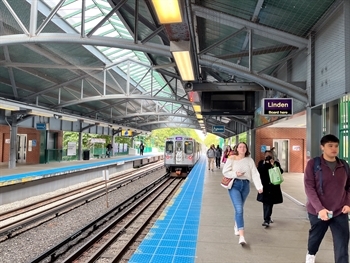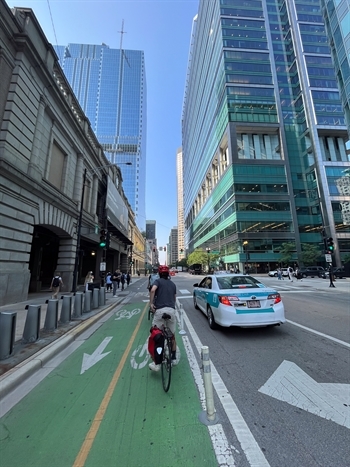New Policies Promote Sustainable Transportation Choices

How do we make transit, biking and walking more appealing than driving so that more people embrace these sustainable transportation options? What if we could make these things better, easier, more of a no-brainer? Activities that encourage sustainable transportation choices are known as Transportation Demand Management (TDM). While we have been way behind other regions like Seattle and Washington DC in implementing these policies, this spring saw two major pieces of good news for TDM in Illinois.
State Bill Helps Workers Save on Transit
In Springfield, House Bill 2068 sponsored by Representative Theresa Mah passed the legislature. This bill requires employers with 50 or more employees located within a mile of fixed-route transit (Metra and Chicago Transit Authority rail stations or CTA and Pace bus stops) to allow those employees to contribute pretax income to transit fares. Because of the pre-tax nature of the program, enrolled companies can see up to 7.65% in payroll tax savings.

Audrey Wennink
Representative Mah explains:
“The fact is that these benefits are already available in the federal tax code, and it’s a lost opportunity if we don’t make it more accessible. It was shocking the low percentage of businesses that offered this benefit. If they don’t offer it, their employees can’t take advantage of it. We wanted to require businesses to offer it and more people might take advantage of mass transit.”
“If we are going to be effective at supporting environmental initiatives this is an important piece. We need to change people’s habits and need to provide incentives to do that. Now is a good time post pandemic to address the decrease in ridership and find ways to encourage people to get back into the routine of using mass transit,” Mah said.
“Most businesses with over 50 employees have some time of platform that would include that as another menu item they could choose from,” she added. There are resources to support employers looking to comply with new requirements. This map shows employers whether businesses fall within one mile of train or bus service, and the Regional Transportation Authority’s Account Setup Guide explains necessary steps to setting up a pretax benefit program. Public Act 103-0291 takes effect Jan. 1, 2024.
Chicago debuts TDM guidance for developments near rail stations
In June, The Chicago Department of Transportation (CDOT) released introductory guidelines for Travel Demand Management plans for new construction developments, rules that encourage developers near transit to incorporate incentives and policies that support biking, walking and transit use by tenants.

Image Credit: Audrey Wennink
As noted in the guidelines, “TDM is important to Equitable Transit Oriented Development because it promotes access to transportation options, addresses transportation affordability, reduces environmental impacts, enhances community connectivity, and helps mitigate displacement risks for marginalized communities.”
Under the Connected Communities Ordinance, if new buildings are being constructed within one-half mile of a rail station, certain provisions kick in to encourage density and promote walkability. Additionally, these TDM guidelines help ensure that developments over a certain size near transit are truly transit-supportive. That means providing amenities supporting active transportation and shared use mobility, implementing policies to discourage driving, and communicating with residents and tenants about them.
CDOT’s implementation of the guidelines is explained further in these Frequently Asked Questions. After piloting the TDM guidelines for up to a year, the agency will develop a final rule to govern this policy.
